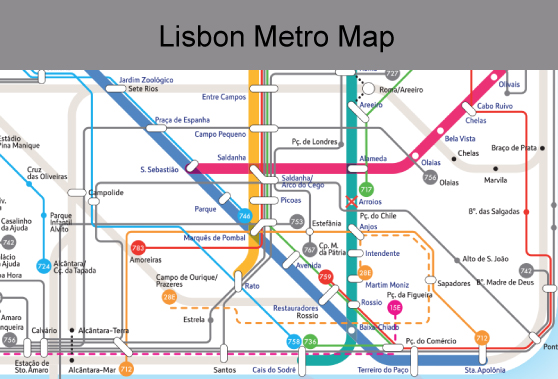The Lisbon Metro, known locally as “Metropolitano de Lisboa,” is the backbone of public transportation in Portugal’s vibrant capital city. Since opening in 1959, this efficient subway system has become an essential part of daily life for both residents and tourists exploring Lisbon’s historic neighborhoods and modern districts.
Network Overview and Coverage
The Lisbon Metro operates four distinct colored lines that span approximately 44 kilometers across the metropolitan area. The Blue Line (Azul) connects Santa Apolónia to Reboleira, serving major tourist attractions and business districts. The Yellow Line (Amarela) runs from Odivelas to Telheiras, providing crucial north-south connectivity. The Green Line (Verde) links Cais do Sodré to Telheiras, while the Red Line (Vermelha) connects São Sebastião to the airport, making it particularly valuable for travelers.
With 56 stations strategically positioned throughout Lisbon, the metro system efficiently connects key areas including the historic Baixa district, modern Parque das Nações, and important transport hubs like Santa Apolónia railway station and Humberto Delgado Airport.
Operating Hours and Frequency
The Lisbon Metro operates daily from 6:30 AM to 1:00 AM, with extended hours until 2:00 AM on Fridays and Saturdays. During peak hours, trains run every 2-4 minutes, while off-peak services maintain intervals of 6-9 minutes. This reliable schedule makes the metro system highly dependable for commuting and sightseeing activities.
Ticketing and Fares
The metro uses the integrated Navegante card system, which also works on buses, trams, and funiculars throughout Lisbon. Single journey tickets cost €1.50, while daily passes offer unlimited travel for €6.40. Monthly passes provide excellent value for longer stays. The contactless Viva Viagem card can be purchased at any station and recharged as needed.
Accessibility and Modern Features
Recent modernization efforts have significantly improved accessibility throughout the network. Many stations now feature elevators, tactile guidance systems, and audio announcements for visually impaired passengers. Free Wi-Fi is available at most stations, and digital displays provide real-time arrival information in multiple languages.
Tourist-Friendly Connections
The Lisbon Metro excels at connecting major tourist destinations. The Blue Line provides direct access to Rossio Square and the historic Chiado district, while the Red Line offers convenient airport connectivity. Oriente station on the Red Line connects to the impressive Gare do Oriente, designed by Santiago Calatrava, and serves the modern Parque das Nações area.
Tips for Visitors
For optimal metro travel experience, avoid rush hours (8-9 AM and 6-7 PM) when possible. Keep tickets validated and accessible, as inspections are common. The metro integrates seamlessly with Lisbon’s famous Tram 28 and other surface transportation, making it easy to create comprehensive sightseeing itineraries.
The Lisbon Metro represents modern Portugal’s commitment to sustainable urban transportation, combining efficiency with affordability while preserving the city’s unique character and charm.

